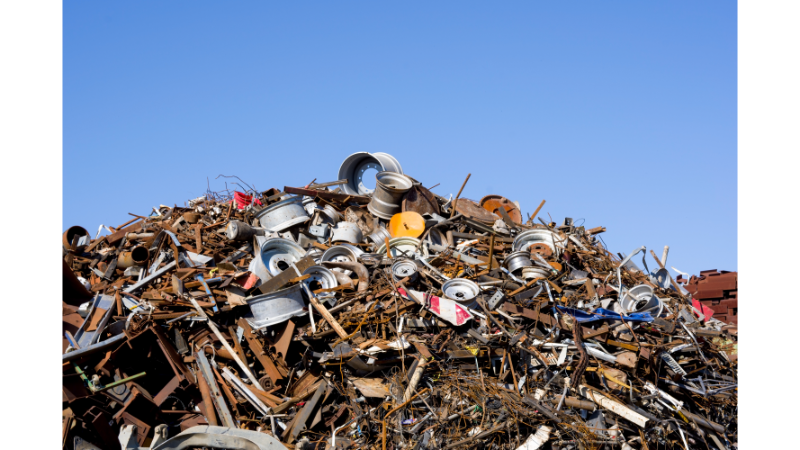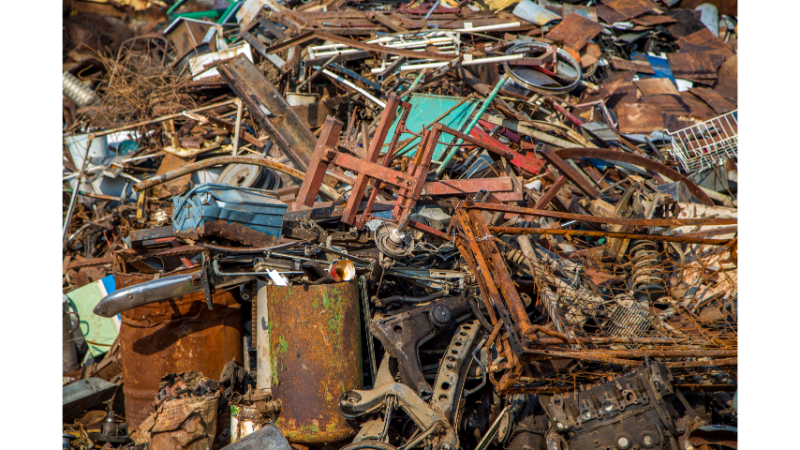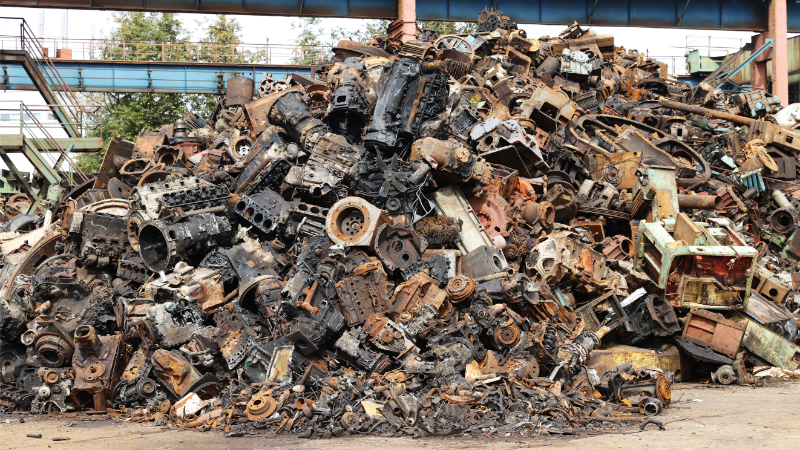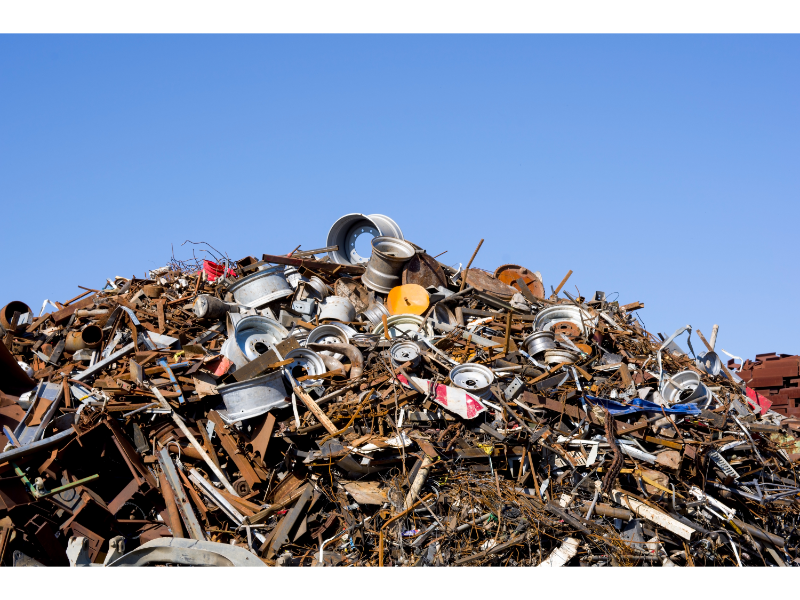Metal waste is a significant type of waste that emerges in almost every area of modern industry. If not managed effectively, it can cause serious environmental damage. Metals used in various sectors, especially construction, automotive, home appliances, electronics, and energy, become metal waste when they reach the end of their service life. These materials are then integrated into waste management systems.
However, the greatest advantage of metal waste lies in its ability to be recycled multiple times. With each recycling cycle, a significant amount of raw material is conserved. This helps slow down the depletion of natural resources. At the same time, it significantly reduces energy consumption and carbon emissions.
The recycling processes of metal waste not only offer environmental benefits but also provide businesses with serious cost advantages. In this article, we will comprehensively examine the types of metal waste. We will also explore the recycling processes, environmental and economic benefits, and their strategic roles in achieving sustainability goals.
Table of Contents
- What Is Metal Waste?
- Examples of Metal Waste
- Classification of Metal Waste
- Metal Waste Recycling Process
- Advantages of Metal Waste Recycling
- Frequently Asked Questions
- Conclusion
What Is Metal Waste?
As industrialization and production activities accelerate, metal waste has started to occupy a larger place in our lives. Metal waste includes materials containing iron, steel, aluminum, copper, and similar metals. These materials have either reached the end of their service life or are surplus from production processes.
If not managed properly, metal waste can cause serious environmental damage. It leads to negative effects such as soil, water, and air pollution. At the same time, it threatens the balance of ecosystems.
However, thanks to effective recycling systems, metal waste transforms into a valuable resource that protects the environment. The recycling process reduces the consumption of natural resources. It also saves energy and decreases greenhouse gas emissions. These environmental contributions of metal waste are of great importance for achieving sustainable development goals.
Metal waste plays a key role in sustainability efforts due to its durable structure and high recycling potential. Metals can be processed and reused repeatedly. They can be recycled without significantly losing their physical and chemical properties. These features distinguish them from other types of waste and make them more valuable.
In addition, metal recycling provides significant economic advantages. Recycled metals reduce the need for new raw materials. As a result, businesses can lower their production costs. At the same time, it decreases import dependency and contributes to the national economy.

Examples of Metal Waste
Metal waste appears in a wide range of forms. Many types of metal are generated in various industries and daily life. Here are common examples of metal waste:
- Scrap iron and steel parts are among the most frequently encountered types of metal. Large amounts of iron and steel waste are generated in the construction, automotive, and heavy industry sectors.
- Aluminum cans and sheets are widely used, especially in beverage and food packaging. After use, these materials are sent to recycling facilities. The recycling rate of aluminum is quite high.
- Copper cables play an important role in the electrical and electronics industries. Cables that have reached the end of their service life can be recycled and turned into raw materials again. Since copper is considered a valuable metal, its recycling is also economically significant.
- Lead, nickel, and zinc materials are commonly used in batteries, accumulators, and various industrial products. These metals are recovered through specialized processing methods and returned to use without harming the environment.
- Used home appliances are an important source of metal waste due to their metal components. When refrigerators, washing machines, and ovens are dismantled, large amounts of metal are recovered.
- Automotive parts contribute to significant amounts of metal during the recycling of scrap vehicles. Engine blocks, chassis parts, and wheels are processed and returned to the economy through recycling.
- Metal components in electronic waste stand out due to the rapidly increasing volume of e-waste. Devices such as computers, mobile phones, and televisions contain various valuable metals.
These examples occur in large quantities on both individual and corporate scales. Therefore, the need for effective management systems and robust recycling infrastructures continues to grow. Proper collection, sorting, and recycling of metal are crucial for both environmental protection and economic benefits.
Classification of Metal Waste
Metal waste is divided into two main groups based on their composition and content. This classification plays a critical role in both planning and executing the recycling process.
Ferrous Metals
Ferrous metals consist of waste materials based on iron and steel. These metals have magnetic properties. Thanks to this feature, they can be easily separated in recycling facilities. They are commonly used in construction, automotive, shipbuilding, and heavy industry sectors. Bridges, buildings, vehicle chassis, and steel frame systems fall under this category. Ferrous metal that has reached the end of its service life can be highly recycled and reused in production. Recycling in iron and steel production significantly contributes to energy savings and the reduction of carbon emissions.
Non-Ferrous Metals
Non-ferrous metals include aluminum, copper, lead, zinc, nickel, and titanium. These metals are known for their corrosion resistance and lightweight properties. They also stand out with their high conductivity and resistance to oxidation. Non-ferrous metals are widely used in high-tech industries such as energy, aviation, electronics, automotive, and healthcare. Many products, from aluminum beverage cans to copper electrical cables, lead batteries to titanium prosthetics, belong to this group. The recycling of non-ferrous metals reduces dependence on raw material imports. It also helps conserve natural resources and minimize environmental impacts.
This classification is critical for the efficient planning of recycling processes. Each metal group requires different processing methods, energy needs, and recycling technologies. Accurate classification maximizes both environmental and economic efficiency.

Metal Waste Recycling Process
The recycling process is carried out meticulously. This prevents resource waste and reduces environmental impacts. Each stage plays a vital role in both efficiency and quality.
- Collection
Metal is collected by being sorted at the source or accumulated at designated collection centers. Industrial facilities, construction sites, automotive services, and municipal waste systems contribute to this collection process. An effective collection system is the first and most critical step of the recycling process. - Sorting
Collected metal is separated according to its types. At this stage, magnetic separators help separate ferrous and non-ferrous metals. In addition, manual checks are used to remove other materials that may remain among mixed waste. Accurate sorting directly affects the efficiency of subsequent processing steps. - Processing
Sorted metals are subjected to crushing and grinding processes. These procedures reduce large metal pieces into smaller sizes suitable for recycling facilities. The smaller metal fragments are easier to handle during the melting stage. - Melting
Metal is melted in specialized furnaces at temperatures suitable for their types and properties. Different melting systems are used for ferrous and non-ferrous metals. During this process, energy consumption is controlled to minimize environmental impacts. - Purification
The molten metal is purified to remove impurities. Special chemical and physical methods are applied at this stage. As a result, high-quality and standard-compliant raw material is obtained. The purification process is one of the most critical steps determining the final product’s quality.
Through these systematic processes, metal is returned to the production cycle for use in new products. In this way, the environment is protected, and economic resources are used more efficiently.

Advantages of Metal Waste Recycling
Metal waste recycling provides many important benefits both environmentally and economically. The advantages offered by this process play a critical role in achieving sustainable development goals.
- Conservation of Natural Resources
Extracting metal ores can cause significant harm to nature. Mining operations lead to environmental problems such as soil erosion, water pollution, and deforestation. Recycling metal waste reduces the need for new ore extraction. As a result, natural resources are preserved, and ecosystems experience less damage. - Energy Savings
The energy consumed in metal recycling is significantly lower compared to new metal production. In metals like aluminum, this savings rate can reach up to 70%. Lower energy consumption reduces production costs and allows energy resources to be used more efficiently. - Reduction of Greenhouse Gas Emissions
Large amounts of carbon are released during new metal production. Recycling processes significantly reduce these emissions. The reduction in carbon footprint makes a serious contribution to combating global warming and climate change. - Economic Contribution
The metal recycling sector offers significant opportunities for job creation and economic value. Recycling facilities, logistics services, and waste collection systems create new business areas. At the same time, it reduces countries’ dependence on foreign raw materials and strengthens economic stability. - Efficiency in Waste Management
Recycling reduces the burden on landfills. Recovering metal waste instead of sending it to dumps helps prevent environmental pollution. Negative effects such as soil, water, and air pollution are minimized.
For these reasons, metal waste recycling provides great benefits to the environment, economy, and society. Thus, it offers a direct and strong contribution to development goals.

Frequently Asked Questions
In which industries is metal waste generated most?
Metal waste is heavily generated in many industries such as construction, automotive, electronics, energy, home appliances, and defense.
What is the recycling rate of metal waste?
Many types of metals have recycling rates above 90%. Especially aluminum and steel have high recycling potential.
Are there metal wastes that cannot be recycled?
Some metal wastes that are heavily contaminated, contain toxic substances, or have severely altered alloys may not be suitable for recycling.
Why is waste recycling important?
It conserves natural resources, saves energy, reduces greenhouse gas emissions, and generates economic benefits.
How is metal waste collected?
Collected through source separation, collection centers, municipal waste management systems, and private companies.
How are ferrous and non-ferrous metal wastes separated?
Magnetic separators are used to separate ferrous and non-ferrous metals from each other.
Which technologies are used in waste recycling?
Technologies such as crushing, grinding, melting, purification, and reshaping are used.
How does metal waste recycling contribute to the economy?
It reduces the need for imported raw materials, lowers production costs, and creates employment and new business opportunities.
What are the negative environmental impacts?
When left uncontrolled in nature, metal waste can cause soil, water, and air pollution. It threatens ecosystems.
Which metals are the most valuable in recycling?
Copper, aluminum, nickel, and some valuable metal alloys are among the most economically valuable metals.
Conclusion
In conclusion, metal waste is an extremely valuable resource both economically and environmentally. Today’s increasing production and consumption activities have made the effective management of metal waste more important than ever. Through an efficient recycling system, natural resources are preserved. At the same time, energy savings are achieved, and environmental pollution is prevented.
The recycling of metal waste plays a significant role in combating climate change by reducing greenhouse gas emissions. It also creates new job opportunities, cost advantages, and independence in raw material supply for the economy.
Burkasan reduces businesses waste burdens with its professional waste management solutions. With specially developed systems for companies, it meticulously manages the entire process from the collection to the recycling of metal waste. In this way, both environmental responsibilities are fulfilled, and a sustainable production model is created for businesses.
For more information and to read our other articles, please visit our blog page.

